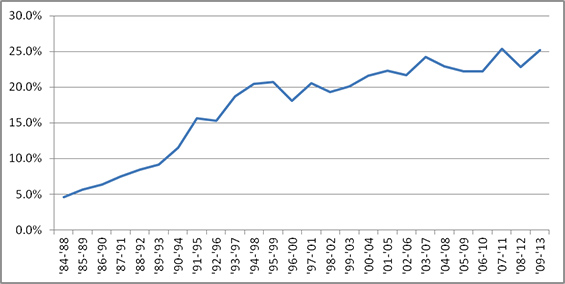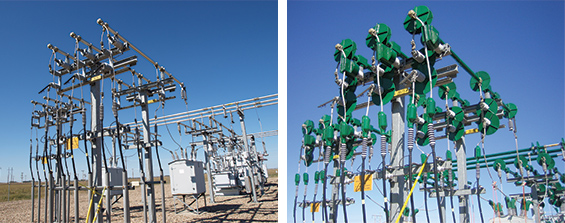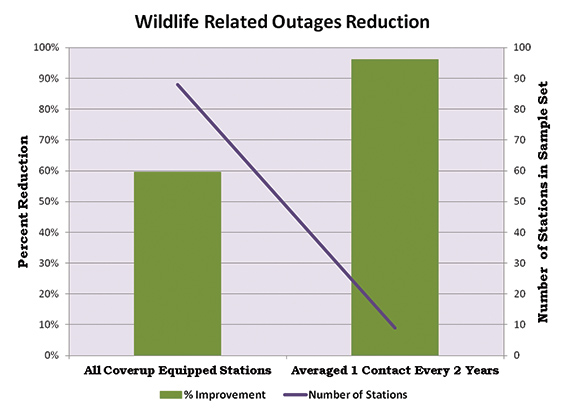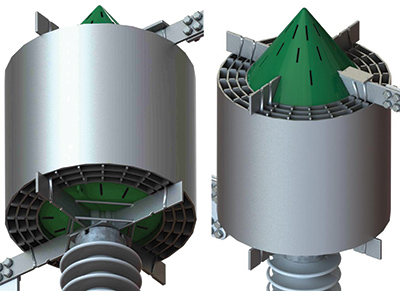Introduction
Wildlife, such as small animals and birds, has been a burden to utilities and system reliability for as long as the modern electrical grid has existed. The lack of attractive nesting areas in some landscapes combined with the inquisitive nature of birds means that electrical substations can attract an alarming level of bird activity. This activity can lead to electrocutions, costly repairs, lengthy outages, and in some cases, violation of wildlife related legislation.
AltaLink is Alberta, Canada’s largest transmission service provider, operating and maintaining over 12,000 kilometres (7,500 miles) of transmission line and approximately 280 substations. The utility has considerable experience managing wildlife impacts on power systems with roughly 20 percent of all substation outages attributed to wildlife contacts (predominantly birds) on low voltage equipment. This is a significant increase over historical levels; the contribution of wildlife to substation outages has risen from 5 to 10 percent in the late 80s and early 90s to over 20 percent from 2003 through 2012 prompting the need for a solution (Figure 1).

Figure 1: Percent of Substation Outages caused by wildlife contacts (5 year rolling average)
In an effort to prevent electrocutions and improve system reliability, AltaLink began testing a new, custom fitted cover-up product called Greenjacket. It is unique among other cover-up products because it is custom fitted to cover various equipment of all shapes and sizes. The product is made out of a highly dialectric, polyurea material that meets the IEEE 1656 industry standard for bird and animal cover-up.

Figure 2: A typical custom cover-up installation using Greenjacket products
Today, Greenjacket is now a formalized program and standard product, where all new substations are outfitted with the product during construction and existing substations are prioritized and retrofitted annually. The goal of the cover-up program is to improve the reliability of the transmission system while minimizing emergency call outs, costly outages to customers, consequential damage to equipment as well as protecting wildlife, including birds. The maintenance savings are derived from the avoidance of unplanned call outs, equipment repairs consequential to any wildlife caused outage, and customer outage costs.

Figure 3: Low-voltage connections and equipment pre-and post coverup installation. The underground connectors, dropout switch bases, lightning arrestors, pipe bus, and breaker bushings are all covered.
The Cost of Wildlife Caused Outages
Wildlife contacts and outages can have significant costs not only to electric utilities but also to the public, customers, and wildlife. A cost-effective solution for mitigating outages is often an easy sell to regulators and customers alike.
Such contacts can result in significant damage within a substation. Typical AltaLink repair costs range from $5,000 to repair or replace smaller equipment and components, such as insulators or arrestors, to as high as $80,000 to replace an entire 25 kV breaker. This is including both material and labour costs and is based on past experience. If the damage is significant a prolonged outage to make repairs is necessary and in some cases a mobile transformer may be required, at a minimum additional cost of $70,000. Additionally, there are costs associated with responding to the initial outage itself, which involves dispatching a crew to travel to the substation and inspect the site. Sending crews out to investigate an unplanned outage takes away from the day’s planned activities and can result in cancelled or deferred work disrupting schedules and maintenance plans.
Despite the potential costs to the utility itself, in many cases the greatest impact of wildlife contacts are to interconnecting customers. For example, a one hour outage to an industrial customer with a 5 MW load valued at a conservative $15 per unserved kWh1 results in a financial impact of $75,000. For even larger customers with sensitive loads and the highest of reliability demands, even a short duration outage can interrupt processes and production for much longer than the duration of the outage itself and have significant financial impacts.
The birds and animals themselves are directly impacted if they are injured or killed from the contact. Depending on the species, this may be considered a legal violation and may require reporting to provincial, federal or state enforcement agencies. At AltaLink, the most common species involved in equipment contacts are crows, ravens, and occasionally owls. Electrocutions involving non-owl raptors – i.e. hawks, eagles and falcons – are rare, as are electrocutions involving water birds. Substations in areas that are favourable habitat for crows and ravens, such as near industrial sites and landfills, typically experience more frequent contacts than substations in areas of less favourable habitat. AltaLink’s substation that has historically experienced the most frequent bird caused outages is located directly across the street from a Class II landfill. This particular substation is subject to extreme bird activity and, as a result, has experienced 8 outages due to bird contacts in the previous 5 years.
Animals such as squirrels, raccoons and weasels can also be electrocuted, causing outages, when they enter the substation looking for shelter or food. These animal caused outages are often catalyzed by the small birds that nest in small cavities such as bus pipes (e.g., house sparrows), and on the undersides of the support beams (e.g., barn swallows). The predatory animals are electrocuted while trying to steal the eggs or young out of their nests.
Despite injury and loss of life, the number of birds electrocuted in substations is unlikely to have any impact on populations. The exception would be if an endangered or threatened species was electrocuted. The greatest impacts continue to lay with the electric utility companies themselves and the interconnected customers they serve.
Adopting Custom Cover-Up
AltaLink began experimenting with Greenjacket custom cover-ups in 2005 after continuing to experience high failure rates with off the shelf type products. Although custom cover-ups came at a higher cost, the volume of wildlife related outages was on the rise and a solution was needed. At that time the local company, Cantega Technologies, had yet to test their Greenjacket product in an in-service substation.
Immediate reliability improvements were observed in the substations with Greenjacket and AltaLink began to adopt the product more widely, all while working closely with the developer to continually improve the product design and application. What began as a spray on application inside an in-service substation, evolved into 3D modelling and manufacturing of the covers off-site.
All utilities, including AltaLink, need to perform maintenance and inspections on equipment on which cover-ups have been installed. Some inspection practices have to be altered on equipment with cover-ups. For example, when infrared scanning or Thermal Imagining is done, particular attention is paid to variances between the phases. When an obvious variance is observed, further investigation is warranted, which would include removing the cover-up and conducting a more detailed investigation. A strong advantage of precise fit cover-ups is that when they need to be removed for equipment maintenance or service, it can be done quickly and easily. Re-installation is simple and quick as precise-fit covers will always fit properly and completely cover potential contact points, eliminating all risk. AltaLink’s experience is that re-installation of a cover typically takes a minute or less.
As a result of the success and continued evolution of the program and because the incremental cost and effort to install the product is minimal, AltaLink’s current practice is to install Greenjacket cover-ups on all low voltage equipment at all newly constructed substations. To date cover-ups have been installed in approximately 80 of their 280 substations and the utility continues to target five installations at existing substations per year. This includes retrofits at sites with existing cover-up to either increase the coverage and/or replace older obsolete fittings.
Learnings
Through the partnership with Cantega, AltaLink was involved in the evolution and expansion of the product to include a wider range of custom fittings for greater coverage of low voltage equipment. Installation practices have improved considerably since the early 2005 trials through the investigation of wildlife contacts and learning what did and did not work.
The greatest challenges with the product are primarily related to installation deficiencies. If not installed correctly, the product may be ineffective in preventing contacts. Ensuring proper training of staff and contractors has proved to be particularly important to address this challenge, as is increased quality control and assurance practices.
Contacts can also continue to occur at sites where there is difficult equipment to cover, such as switches and airbreaks, or where gaps need to be left for bonding. Every instance of a bird finding a tiny spot in which to poke its beak provides an opportunity to learn how to better cover substation equipment. In this way, the standard remains a living document that is continuously improved upon.
Another challenge faced by AltaLink is difficulty in acquiring the necessary outages to install cover-ups. This is particularly an issue at higher load substations serving industrial customers with large production facilities where an outage is not an option. To overcome this challenge, AltaLink has tested and approved a new technique for installing cover-ups on energized equipment (Figure 4). Although de-energized installations are the preferred method, this technique allows for greater flexibility. It does however require careful planning and precise execution. On any energized installation, AltaLink staff work closely with Cantega’s experienced hotline certified crews with safety as the primary focus.

Figure 4: Energized installation using specialized hotline tools.
Effectiveness Evaluation
To date AltaLink’s cover-up program has resulted in material and measureable improvements in reliability. To assess the effectiveness of the program a thorough examination and comparison of performance before and after the installation of cover-ups was performed; effectiveness evaluation is ongoing annually. When evaluating those stations which had a history of at least one wildlife related contact every two years, the frequency of contacts drops from 0.67 to 0.03 following the installation of cover-ups (Figure 5). This amounts to a 95 percent reduction in wildlife related contact, including those contacts that were not mitigated due to faulty and/or poor installation practices (Figure 6). This has in turn translated to improved customer performance and customer savings by reducing overall SAIFI (frequency of interruptions) by greater than 3 percent and SAIDI (interruption duration) by greater than 8 percent.

Figure 5: For stations which had a history of at least one wildlife related contact every two years

Figure 6: The green bars represent percent improvement while the Purple line indicates the number of stations in the sample set.
Cost Benefit Analysis
The benefits are clear. Not only is the program a win-win in terms of reducing bird electrocutions and the resulting outages and maintenance costs, it also results in significant savings to customers who expect highly reliable service. Performing a conservative Cost- Benefit analysis to the hypothetical example discussed earlier results in an internal rate of return of 17 percent and a payback of 7 years.
And, the effective service life of Greenjacket is well in excess of 20 years, so we consider this to be a long term, highly cost effective solution. With lower cost installations, such as on smaller or simpler sites, the return is even greater at 33 percent and a payback of 3.5 years! The analysis takes into account typical installation costs, outage rates, product effectiveness, and maintenance costs. It assumes the following: Site average of one contact every three years; Maintenance cost of $8,000 per outage; Product is 100 percent effective; Installation cost of $90,000-$180,000; Customer load is 5 MW valued at $15 per unserved kWh; and 2.15 percent Inflation rate.
Unique Solutions and Benefits
The benefits of working closely with a custom cover-up company don’t end at outage mitigation. Birds will opportunistically nest in exposed cavities and small openings (e.g., substation bus pipes and gussets), which can lead to outage problems. In 2011, covers were designed for grounding reactors which have historically offered nesting opportunities for the Black-billed Magpie (Figure 7). A similar project in 2013 covered potential nest sites for the Great Horned Owl in a substation where a pair had been nesting for several years. Great horned owls will nest in open cavities where there is some overhead cover such as the gussets of support columns in air break structures. AltaLink installed covers at 30 of these sites in one particularly problematic substation (Figure 8). The flexibility of the company to tailor custom solutions to a variety of issues and impacts is a clear side benefit of the relationship.

Figure 7: Grounding reactor, bottom and top view, used to prevent nesting by the Black-billed magpie.

Figure 8: Gusset (left) and cover (right) to prevent nesting by Great Horned Owls.
Discussion
The impacts of wildlife caused outages and solutions are obvious. Mitigating wildlife contacts by even a fraction let alone upwards of 95 percent is a clear win-win scenario as wildlife cause unacceptably high volumes of outages resulting in service interruptions to customers and equipment damage.
To date, AltaLink’s custom cover-up program has reduced wildlife outages by upwards of 95 percent at sites with installations, has reduced overall SAIDI by over 8 percent and SAIFI by over 3 percent, with material and measureable improvements in reliability performance.
The cover-ups have been such a success at AltaLink that in 2007 the program earned the President’s Award of Excellence. The President’s Award is an annual award to recognize the outstanding work and innovation of employees. The cover-ups also form an integral component of AltaLink’s Avian Protection Plan (APP), a management system specifically designed to reduce bird impacts with electrical equipment and infrastructure.
Where solutions such as this exist, companies should be willing to adopt proven technologies to not only protect equipment and prevent outages but also to protect wildlife. Custom cover-up products such as Greenjacket offer a cost effective solution, as is clear from the results and cost-benefit analyses presented here. AltaLink would encourage any utility to review their wildlife caused outages and consider a custom solution.
About the Authors
Nikki Heck is a Professional Biologist working in the electric utility industry in Alberta, Canada. She has been employed by Alberta’s largest transmission service provider, AltaLink, since 2004 and as part of her role, wrote and implemented Canada’s first Avian Protection Plan. Nikki has a Master’s degree from the Faculty of Environmental Design at the University of Calgary where her thesis work was conducted on avian interactions with transmission lines.
Todd Sutherland is a Professional Engineer working in the electric utility industry in Alberta, Canada. He has been employed by Alberta’s largest transmission service provider, AltaLink, since 2007 and is currently the chair of the Canadian Electricity Association (CEA) Committee on the Collection of Outage Statistics (CCOS). Todd has Bachelor’s degrees in Electrical Engineering and Computer Science from the University of Saskatchewan.







